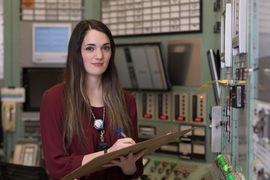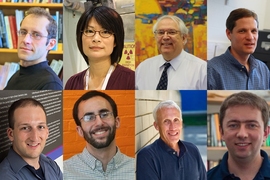When he first reported to MIT’s Nuclear Reactor Laboratory (NRL) as an undergraduate in 2002, David Carpenter anticipated a challenging research opportunity. To his surprise, he found his calling.
It all began with a project investigating durable new materials for use in reactors.
“We were testing silicon carbide, which looked like a good possibility for an accident-tolerant fuel,” recalls Carpenter ’06, SM ’06, PhD ’10. “We were irradiating it inside the reactor — it was the first time anyone had ever done this — and I realized that when we pulled the material out, we would get to see something no one had ever seen before,” he says.
After 15 years at the NRL conducting research and earning degrees in nuclear science and engineering, Carpenter’s appetite for scientific discovery remains sharp, as does his commitment to improving both the performance and safety of current and next-generation nuclear reactors. Today, as the group leader for reactor experiments, he juggles projects brought to the facility by industry, government, and academic institutions. Throughout this time, he says he has never lost his appreciation for the NRL as a singular laboratory for scientific discovery.
“I see the reactor as a machine that generates radiation for testing, and when you put things inside, you can get knowledge out,” he says. “I also appreciate that I get to work each day with this machine and understand how really unique it is, and to some people, maybe a bit mysterious.”
It’s a job that also provides purpose. “I do have a sense of mission, an interest in pushing nuclear engineering to gain more acceptance, developing a real piece of technology for the future that can bring a carbon-free source of substantial energy,” he says.
The MIT Reactor (MITR) is a light-water cooled facility and one of the few on-campus reactors of its kind. It operates 24 hours per day, 7 days per week throughout the year, except for planned maintenance and refueling. While a highly-skilled staff operates and monitors the facility, Carpenter’s role means that he is always on call. “If anything happens to the experiment, or if there are any interruptions in reactor operations, I’ll be involved,” he says.
On a typical day, Carpenter tends to what he calls “the care and feeding of experiments” which take place in three separate research environments situated in the reactor core. All three rely on the MITR for a radiation environment, but each can be tuned to produce specific pressures and temperatures in gas, water or other media. The MITR serves as an ideal facility for developing and testing materials and instruments that can withstand the most extreme conditions and meet the challenges of nuclear reactor operations.
Among the projects Carpenter is shepherding are several with the potential to make critical impacts on the nuclear energy industry. One is the continuation of his silicon carbide research, which was the subject of both his master’s and PhD dissertations, and which triggered significant interest outside of academia.
Carpenter’s focus has involved deploying silicon carbide, a type of ceramic, as a first-line containment barrier in reactors. Since the 1950s, Carpenter explains, nuclear reactors have used uranium pellets stacked up in fuel rods made of zirconium alloys. “These rods are the first barrier against the release of radioactive material from the reactor, but as we’ve seen at the incidents at Fukushima and Three Mile Island, they can melt down in certain circumstances.”
In contrast, silicon carbide in a reactor “gets really hot and sits there and just takes it, without getting soft and melting,” Carpenter says. Using MITR, he has subjected the material to the kinds of temperatures, water pressures, and chemistries that might be found in a full-power reactor. “We’ve gone through many iterations in a process lasting over 15 years, with many tweaks along the way,” he says.
Carpenter believes this research has game-changing potential. “You could retrofit hundreds of existing reactors, making them much safer and more reliable overnight,” he says. But shifting to silicon carbide as an acceptable fuel cladding faces a number of challenges. Government and industry require a degree of certainty about new materials that necessitates more in-reactor testing.
“Silicon carbide remains a very promising material, and it’s sitting in our reactor even as we speak,” he says. But there are also concerns that some of the ceramic can dissolve in water and travel downstream, and that the material may not have the necessary level of “elastic forgiveness,” he says, tending to crack and shatter under stress.
Nevertheless, for Carpenter, this represents a fascinating engineering challenge. He imagines solutions that might involve weaving silicon fibers to achieve the required ductility, to enable a ceramic material to behave like a metal under some circumstances.
As he investigates these possibilities, Carpenter is also invested in novel work on behalf of clients. Among these is a multi-university project funded by the U.S. Department of Energy to develop a high-temperature, salt-cooled reactor. “The design is intrinsically safe because the fuel doesn’t melt, and the salt can withstand high temperatures without requiring thick, pressurized containment buildings,” he says. “You can generate more power, more efficiently, and salt-cooled reactors are inherently much safer,” he says.
The challenges to designing this new kind of reactor involve finding optimal construction materials, since super-hot radioactive salt is highly corrosive. Carpenter is tasked with figuring out how to configure the MITR to simulate a reactor operating at 700 degrees Celsius with molten salt. He must also contend with the radioactive tritium that is released when neutron radiation hits salt.
“Much of our work involves creating a special environment in the reactor,” he says. “Our job is to help clients figure out a practical way of answering the questions they’re posing.”
To perform his job, Carpenter must be a jack of all trades, whether using robot arms to manipulate projects in the reactor hot cells, or performing computational simulations. “I get to have a hand in pretty much everything, from plumbing, electrical work, and programming to conceptual design and installations,” he says.
This comes naturally to the former Eagle Scout from Atlanta who also enjoyed assembling scale models of Star Trek’s Starship Enterprise. He says a “bring a parent to school” event helped seed his interest in nuclear energy. “A parent who worked for a nuclear utility company brought plastic fuel pellets to our class, and told us that one actual nuclear pellet represented tons of coal and barrels of oil,” he recalls. “I took that pellet home and taped it to my wall, and the idea that nuclear energy could do that really stuck with me.”
When Carpenter arrived at MIT, a classmate easily nudged him toward pursuing nuclear science and engineering as a major. It was a short leap for Carpenter to seek out work at the campus reactor.
“I got involved in research I liked, and kept doing it, with different experiments blossoming into my undergraduate thesis, then my graduate thesis, and then it seemed natural to keep working in the same lab,” he says.
Though he never intended to stay this long, Carpenter says he is “really happy" with the work going on at the NRL. He says he is seeing a new wave of interest in nuclear technology research, and looks forward to cultivating students who bring the kind of commitment he felt when he first joined.
“It would be great to stay long enough to see the silicon carbide materials program grow from sketches on paper to being implemented in reactors,” he says. “I hope I’ll be around to see it.”










